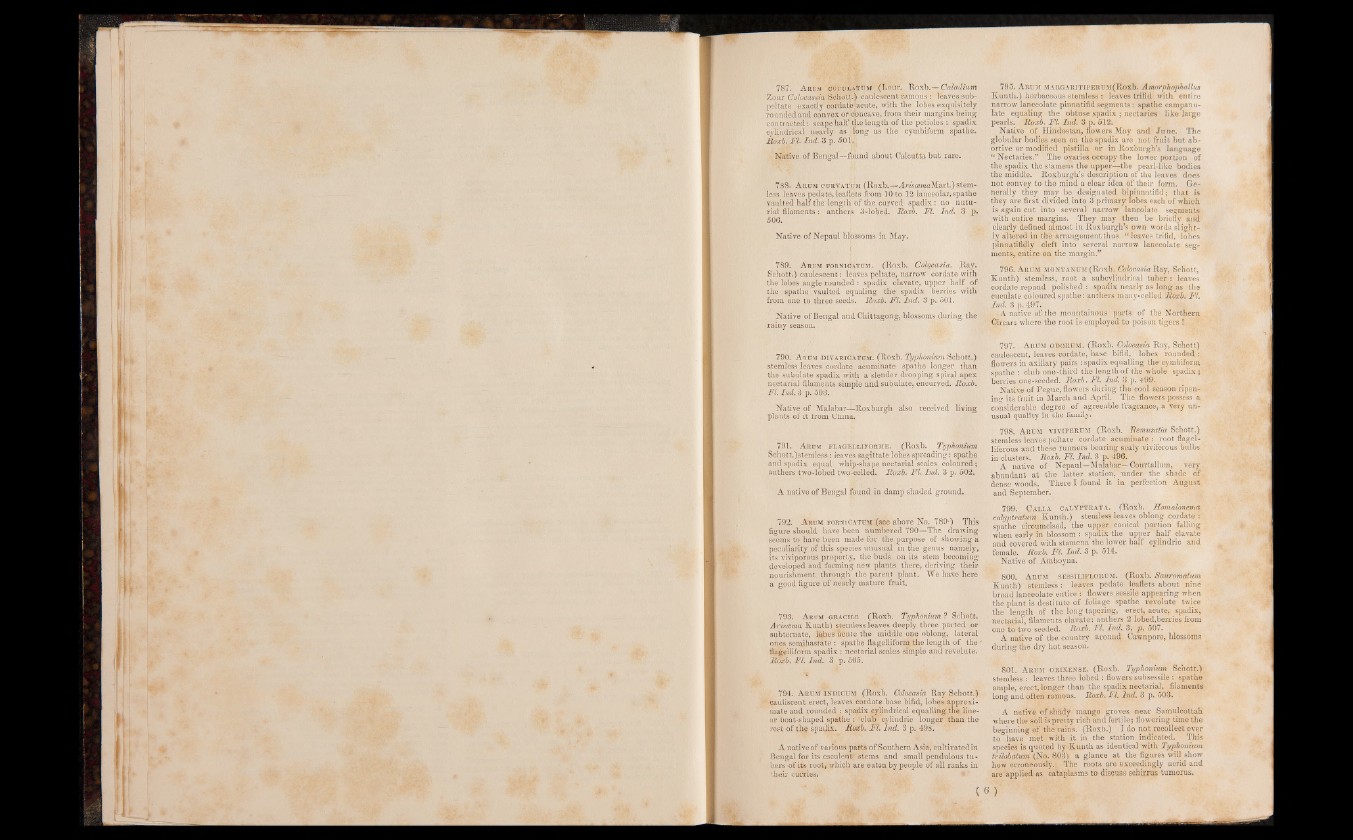
787. Arum cuculaTUm (Lour. Roxb.—Caladium
Zour Colocassia Schot|.) caulescent ramous: leaves sub-
peltate exactly eordate|acute, with the lobes exquisitely
rounded and convex or concave, from their margins being
contracted: scape half the length of the petioles : spadix
cylindrical nearly as long as the cymbiform spathe.
Roxb. Fl. Ind. 3 p. 501.
Native of Bengal—found about Calcutta but rare.
788. Arum curvat'um (Roxb.—AriscemaMatt.') Stemless
leaves pedate, leaflets from 10 to 12 lanceolar, spathe
Vaulted half the length of the^curved spadix : no nutu-
rial filaments: anthers 3-lobed. Roxb. FI. Ind. 3 p.
506.
Native of Nepaul blossoms in May.
789. Arom fornioatum. (Roxb. Colocasia. Ray.
Schott.) caulescent: leaves peltate, narrow cordate with
the lobes angle rounded : spadix clavate, upper half of
the spathe vaulted equaling the spadix berries with
from one to three seeds. Roxb. Fl. Ind. 3 p. 501.
Native of Bengal and Chittagong, blossoms during the
rainy season.
790. Arum divariCatum. (Roxb. Typhonium Schott.)
stemless leaves cordate acuminate spathe longer than
the subulate spadix with a slender drooping spiral apex
nectarial filaments simple and subulate, eheurved. Roxb.
Fl. Ind. 3 p. 503.
Native of Malabar—Roxburgh also received living
plants of it from China.
791. Arum flaGELliforme. (Roxb. Typhonium
Schott.)stemless: leaves sagittate lobes spreading: spathe
and spadix equal whip-shape nectarial scales coloured;
anthers two-lobed two-celled. Roxb. Fl. Ind. 3 p. 502.
A native of Bengal found in damp shaded ground.
792. Arum fokniCatum .(see above No. 789-) This
figure should hare been numbered 790—The drawing
seems to have been made for the purpose of showing a
peculiarity of this species unusual in the genus namely,
its viviporous property, the buds on its stem becoming
developed and forming new plants there, deriving their
nourishment through the parent, plant. We have here
a good figure of nearly mature fruit.
793. Arum orach.b (RoXb. Typhonium ? Schott.
Ariscema Ifunth) stemless leaves deeply three parted or
subteruate, lubes acute the middle one oblong, lateral
ones sen\ihastate : spathe flagelliform* the length of the
flagellifofm spadix : nectarial scales simple ana revolute.
Roxb. Fl. Ind. 3 p. 505.
794. Arum indicuM (Roxb. Colocasia Ray Schott.)
cauliscent erect, leaves cordate base bifid, lobes approximate
and roundedspadix cylindrical equalling the linear
boat-shaped spathe : club' cylindric longer than the
rest of thg spadix. RoXb. Ft. Ind. 3 p. 498.
A native of various parts of Southern Asia, cultivated in
Bengal for its esculent?- stems and small pendulous tubers
of its rooty which are eaten by people of all ranks in
their curries.
795. Arum MARGARiTiFERUM(Roxb. Amorphophallus
Runth.) herbaceous stemless : leaves trifid with entire
narrow lanceolate pinnatifid segments: spathe campanu-
late equaling the obtuse spadix ; nectaries like large
pearls. Roxb. Fl. Ind. 3 p. 512.
Native of Hindostan, flowers May and June. The
globular bodies seen on the spadix are not fruit but abortive
or modified pistilla or in Roxburgh’s language
“ Nectaries.” The ovaries occupy the lower portion of
the spadix the stamens the upper—the pearl-like bodies
the middle. Roxburgh’s description of the leaves does
not convey to the mind a clear idea of their form. Generally
they may be designated bipinnatifid; that is
they are first divided into 3 primary lobes each of which
is again cut into several narrow lancolate segments
with entire margins. They may then be briefly and
clearly defined almost in Roxburgh’s own words slightly
altered in the arrangement thus “ leaves trifid, lobes
pinnatifidly cleft into several narrow lanceolate segments,
entire on the margin.”
796. Arum montanum (Roxb. Colocasia Ray, Schott,
ELunth) stemless, root a subcylindrical tuber : leaves
cordate repand polished : spadix nearly as long as the
Guculate coloured spathe: anthers many-celled Roxb. Fl.
Ind. 3 p. 497.
i;};-:. A native of-the mountainous parts of the Northern
Circars where the root is employed to poison tigers !
797. Arum odorum. (Roxb. Colocasia Ray, Schott)
caulescent, leaves cordate, base bifid, lobes rounded :
flowers in axillary pairs : spadix equalling the cymbiform
spathe : club one-third the length of the whole spadix;
berries one-seeded. Roxb. Fl. Ind. 3 p. 499.
Nativ.e of Pegue, flowers during the cool season ripening
its fruit in March and April. ' The flowers possess a
considerable degree of agreeable fragrance, a very unusual
quality in the family.
798. Arum viviPERGM (Roxb. Remusatia Schott.)
stemless leaves peltate cordate acuminate •: root flagel-
liferous and these runners bearing scaly viviferous bulbs. -
in clusters. Roxb. Fl. Ind. 3 p. 496.
A native of Nepaul—Malabar—Courtallum, very
abundant at the latter station, under the shade of ,
dense woods. There I found it in perfection August
and September.
799. Calla caLYPTRATA. (Roxb. Homalonema
calyptratum ELunth.) stemless leaves oblong cordate :
spathe circumcised, the upper conical portion falling
when early in blossom: spadix the upper half clavate
and covered with stamena the lower half cylindric and
female. Roxb, Fl. Ind. 3 p. 514.
Native of Amboyna.
^ 800. Arum sessiliflorum. (Roxb. Sauromatum
Kunth) stemless : leaves pedate leaflets about nine
broad lanceolate entire : flowers sessile appearing when
the plant is destitute of foliage spathe revolute twice
the length of the long tapering, erect, acute, spadix,
nectarial, filaments clavate: anthers 2 lobed,berries from
one to two seeded. Roxb. Fl. Ind. 3, p. 507.
A native of the country around Cawnpore, blossoms
during the dry hot season.
801. Arum orixense. (Roxb. Typhonium Schott.)
stemless : leaves three lobed : flowers subsessile : spathe
ample, erect, longer than the spadix nectarial, filaments
long and often ramous. Roxb. Fl. Ind. 3 p. 503.
A native of shady mango groves near Samulcottah
where the soil is pretty rich and fertile; flowering time the
beginning of the rains. (Roxb.) I do not recollect ever
to have met with it in the station indicated. This
species is quoted by Kuuth as identical with Typhonium
trilobatum (No. 803) a glance at the figures will show
how erroneously. The roots are exceedingly acrid and
are applied as cataplasms to discuss schirrus tumorus.